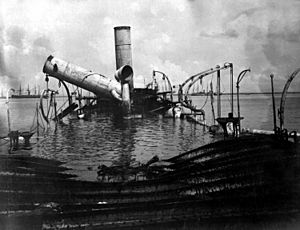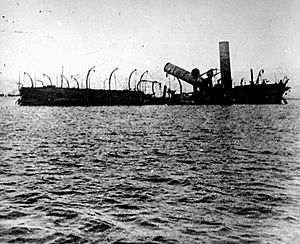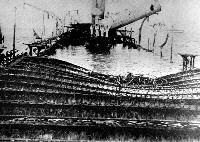Spanish cruiser Reina Cristina facts for kids

The wreck of Reina Cristina after the Battle of Manila Bay in 1898.
|
|
Quick facts for kids History |
|
|---|---|
| Name | Reina Cristina |
| Namesake | Maria Christina of Austria, Queen Consort of Spain |
| Builder | Ferrol |
| Launched | 2 May 1887 |
| Fate | Sunk 1 May 1898 |
| General characteristics | |
| Class and type | Alfonso XII-class cruiser |
| Displacement | 3,042 tons |
| Length | 278 ft 3 in (84.81 m) |
| Beam | 43 ft 4 in (13.21 m) |
| Draft | 20 ft 0 in (6.10 m) |
| Installed power | 4,400 ihp (3,300 kW) |
| Propulsion | 1-shaft compound |
| Speed |
|
| Endurance |
|
| Complement | 370 officers and enlisted |
| Armament |
|
The Reina Cristina was a Spanish Navy warship. It was an Alfonso XII-class, a type of ship called an unprotected cruiser. This means it did not have heavy armor to protect it in battle. The ship was built in Ferrol and launched on May 2, 1887.
Reina Cristina spent its first few years in Spanish waters. Later, in 1894, it moved to the Spanish Navy's Asiatic Squadron. Its job was to protect Spanish islands in the Pacific from the German Empire.
The ship also helped Spain during the "Tagalog Revolt" (1896–1897) in the Philippine Islands. This revolt was part of the Philippine Revolution. Reina Cristina patrolled the waters to stop illegal goods from reaching the rebels. It also fired its guns to support the Spanish Army on land.
Reina Cristina was later sunk during the Battle of Manila Bay. This happened on May 1, 1898, by the United States Navy. This battle was the first big fight of the Spanish–American War.
Contents
Ship Design and Features
Reina Cristina was built in Ferrol and launched in 1887. It had two tall funnels. Its main guns were made by Hontoria and placed on the sides of the ship. The ship also had five fixed torpedo tubes. Two were at the front, one on each side, and one at the back.
Even though it had no armor, Reina Cristina was designed to resist sinking. It had 12 watertight sections. These sections were like separate rooms that could be sealed off if the ship was hit. This design helped prevent the ship from flooding completely.
The ship was meant for duties in colonies, like stopping smugglers and pirates. It was designed to be fast and have a good amount of weapons. However, it had ongoing problems with its engines. This meant it could not reach its planned top speed. In reality, its fastest speed was about 10 knots (19 km/h; 12 mph). Because it lacked armor, it was not ready for a big battle against heavily armed ships, like those it met in Manila Bay in 1898.
Life and Battles of the Ship
Reina Cristina started its service in Spanish waters. In 1894, it moved to the Spanish Asiatic Squadron. It became the main ship, or flagship, of this squadron. Its job was to protect Spanish islands in the Pacific.
When the "Tagalog Revolt" began in the Philippine Islands, Reina Cristina played an active role. It helped the Spanish forces try to stop the revolt. The ship patrolled the waters to prevent supplies from reaching the rebels. It also supported the Spanish Army by firing its guns from the sea. This helped troops on land in places like Cavite and Novaleta.
The Spanish-American War Begins
In April 1898, the Spanish–American War started. Reina Cristina was the flagship for Rear Admiral Patricio Montojo de Pasaron's squadron in Manila, Philippine Islands. On April 25, 1898, Reina Cristina and the other ships left Manila Bay. They headed to Subic Bay. Montojo thought this bay would be safer because of mines and shore guns.
However, when they arrived, Montojo found that most of the mines were not laid. Also, the shore guns were not ready. So, on April 28, Montojo decided to return to Manila Bay. He believed fighting near Cavite would be better. The shallow water there would also mean fewer lives lost if ships sank.
On April 29, Reina Cristina and the squadron left Subic Bay. Another ship, the wooden cruiser Castilla, had engine trouble. So, Reina Cristina had to tow it. The squadron reached Cavite later that day. They anchored in Cañacao Bay, near the Cavite Peninsula.

The Battle of Manila Bay
At 4:00 AM on May 1, 1898, Montojo's squadron was still anchored. He signaled all ships to get ready for battle. Reina Cristina prepared for an American attack. Just before 5:00 AM, the United States Navy's Asiatic Squadron was seen. It was led by Commodore George Dewey. Soon, the first shots of the Battle of Manila Bay were fired. This was the first big fight of the Spanish–American War.
Reina Cristina quickly got ready to move. At 5:20 AM, it began firing its guns, along with the other Spanish ships and shore batteries. However, Dewey's ships were still too far away. Finally, at 5:40 AM, the U.S. squadron fired back. Their powerful protected cruisers, USS Olympia, USS Baltimore, and USS Boston, focused their fire on Reina Cristina.
Soon after, Reina Cristina was hit twice. These hits damaged some of its smaller guns and started fires. The crew quickly put out the flames. The American squadron then turned around and made a second pass, firing again. This time, Reina Cristina was hit many more times. Fires broke out again, and many crew members were hurt. Montojo ordered the back ammunition room to be flooded. This was to prevent a huge explosion. Dewey's ships then turned again for a third firing pass.
As the American squadron prepared for a fourth pass, Montojo ordered Reina Cristina to move. It slowly steamed toward Dewey's main ship, Olympia. Montojo intended to ram Olympia. This made Dewey order his squadron to get closer and focus all their fire on Reina Cristina. The distance between the ships quickly closed to 1,200 yards (1,100 m).
Reina Cristina was soon burning in many places. Most of its guns were destroyed. Its steering was broken, and it had many holes in its hull, funnel, and mast. Half of its crew, including seven officers, were killed or wounded.
Seeing that Reina Cristina could not be saved, Montojo ordered it to be sunk and abandoned. The gunboats Isla de Cuba and Isla de Luzón came alongside to rescue the wounded. American gunfire continued to hit Reina Cristina, causing more injuries. Among those killed was Reina Cristina's captain, Luis Cadarso y Rey. He refused to leave his ship until all his men were safe. Reina Cristina, a burning wreck, soon sank.
Remembering the Ship
To honor Reina Cristina's bravery in the Battle of Manila Bay, Commodore Dewey gave some of its guns to the United States Revenue Cutter Service. Four of the ship's 3-pounder Hotchkiss revolving guns were taken from the wreck. These guns, each with five spinning barrels, are now displayed. You can see them in pairs at the front of Hamilton Hall at the United States Coast Guard Academy in New London, Connecticut.
See also
 In Spanish: Reina Cristina (1890) para niños
In Spanish: Reina Cristina (1890) para niños



